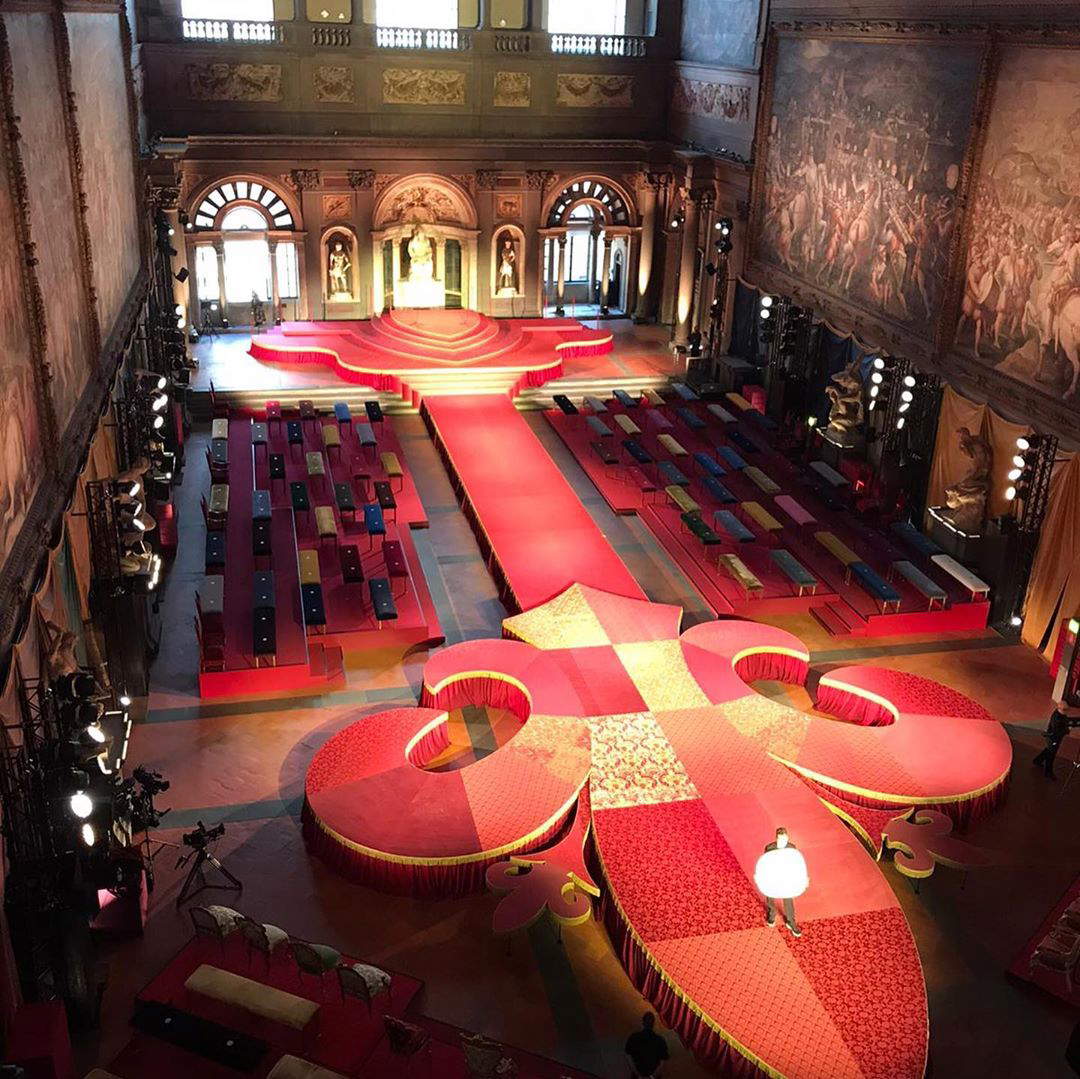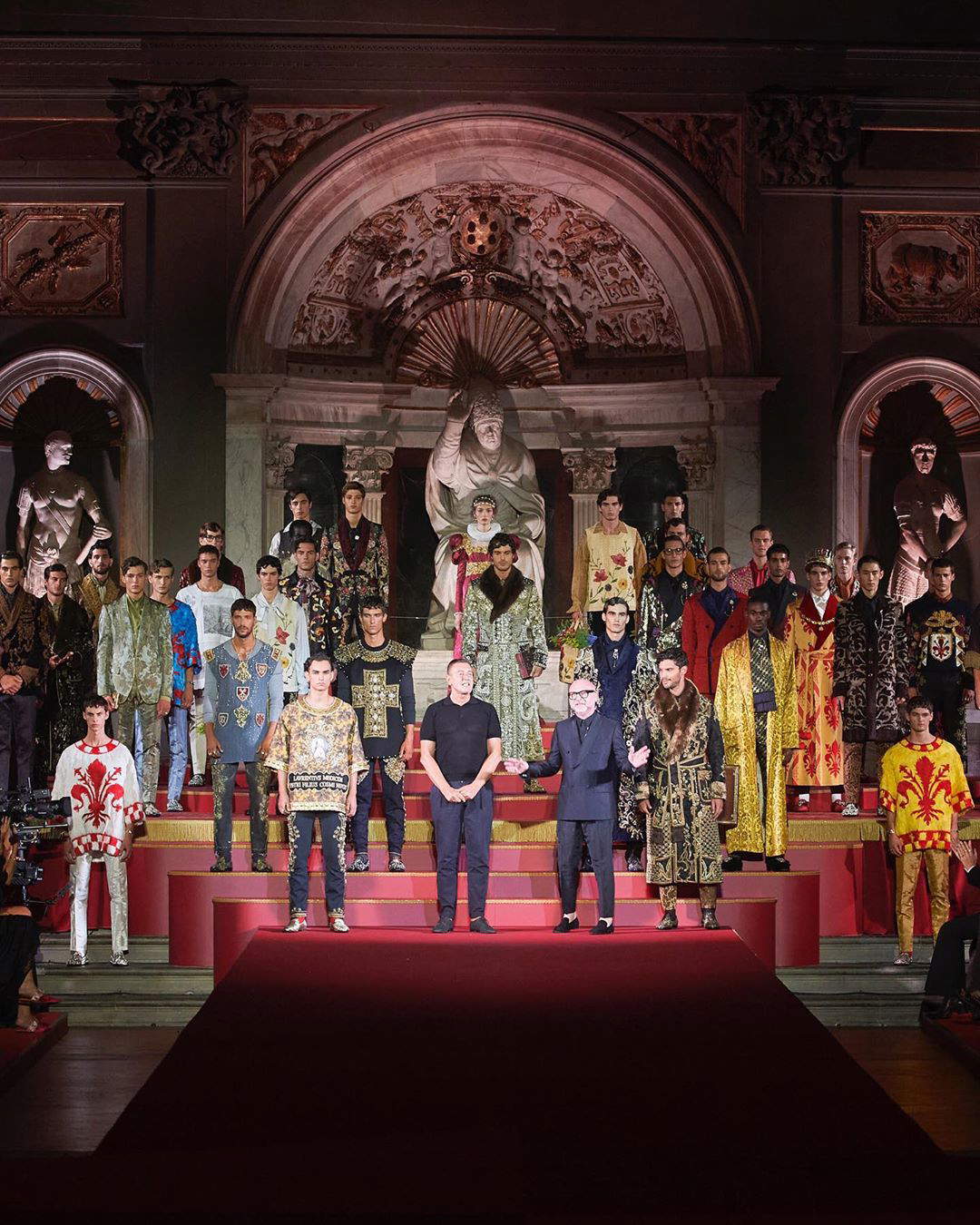Almost two weeks of closure to allow a private individual to organize his own party in a public space: this is what happens, amid general silence, in Florence, where Palazzo Vecchio keeps its doors closed for no less than thirteen consecutive days (eight of which are closed to the public), from August 23 to September 5, in conjunction with Dolce & Gabbana ’s fashion show-event, and related preparations, in the Salone dei Cinquecento. Initially it was thought that the closure would be limited to Piazza della Signoria, as we denounced at the beginning of August, and already it would have been very unacceptable to prevent everyone from accessing a public square in order to allow the maison to prepare a dinner for a handful of guests on its pavement: it then turned out, scrolling through the August 18 resolution, that there would not only be the closure of the square (D&G needed it for their cocktail party on the evening of September 2), but as per the attached timetable, Palazzo Vecchio had also been committed for almost half a month. It was necessary, after all, to adjust the Salone del Cinquecento for the fashion show, set up the production office and the hair and makeup area in the Sala d’Arme, assemble the creations of the two designers and their guest artisans in the Cortile di Michelozzo, transform the Sala dei Duecento into a dressing room for dressing the models, and so on: all operations requiring certain timelines.
Visitors who would have liked to get to know Vasari’s frescoes, to see Donatello’s Judith or Verrocchio’s Putto up close, to walk through Eleonora di Toledo’s neighborhood with Bronzino’s decorations, to linger in the Cappella dei Priori or the Sala dei Gigli, will have to reschedule their intentions: on the official website of Palazzo Vecchio, a notice communicates, very laconically, that on August 23, 24, 28, 29, 30 and 31 and September 4 and 5, the museum is “closed for institutional reasons.” And it is not difficult to guess what these institutional reasons are by consulting the schedule. Of course, for the sake of completeness it is necessary to add that on Tuesdays, Wednesdays and Thursdays Palazzo Vecchio is already closed by itself (which is why some dates between August 23 and September 5 are not mentioned): a restriction of visiting days that arrived in the post-Covid period. So someone may object by asserting that there are actually only eight days of actual closure. If anything, we will ask this someone if the situation still seems acceptable to them.
Now, even if we want to dispense with even the slightest ideal glimmer about the concept of common good and analyze the issue from a purely utilitarian point of view, one could simply ask how much the municipality has collected from D&G for the concession of the rooms in Palazzo Vecchio. Reading the resolution, one will come across a new surprise when one realizes that the Municipality has in fact given Palazzo Vecchio to Dolce and Gabbana: the Municipality has in fact “deemed [...] to facilitate the organization of the aforementioned initiative” through the application of certain municipal provisions “compatible with the nature of the event and with the public interest objectives connected to the same.” These provisions are “the exemption in favor of the concessionaire from the payment of all charges ordinarily provided for the concession respectively of monumental environments, movable property (chairs, barriers, etc..; unless a deposit is required), plants and floral arrangements owned by the City of Florence,” the “50 percent reduction” of COSAP, or the fee for the occupation of public land, “the free ZTL access and parking permit in favor of public and private entities that organize events and manifestations of the Municipality or sponsored by the same,” the exemption from the amounts due for services performed by the Municipal Police Corps personnel in relation to services aimed at the safety and fluidity of traffic during the event, the “free of charge of any participation [....] of the Historical Procession of the Florentine Republic.”
So what is the high public interest that prompted the City of Florence to make such benevolent concessions to the two Sicilian designers? The points listed in the resolution help to get an idea: the Municipality stresses “how this is the first time that a major international fashion brand decides to present its collection organically associated withAlto Artigianato Fiorentino which, presented as a network of multiple excellences resulting from specific historical traditions, will be able to enjoy a promotional and media exposure otherwise difficult to obtain”; that “these events will be the first, after the health emergency, to be held in Italy on a physical and not digital level, thus launching internationally a decisive message of courage, openness and security, functional to the revival of the productive, tourist, commercial activities of the City.” that “the event is not for direct profit and, in particular, that the participation of the Dolce and Gabbana fashion house in the event organized in collaboration with Discovery Foundation is detached from the typical ways of commercial promotion, because of the unique production specimens that will be exhibited and precisely because of their significant combination with high-end handcrafted products of the territory and the adoption of modes of presentation and communication distinct from the ordinary fashion ones.”
 |
| The catwalk for the fashion show in the Salone dei Cinquecento |
 |
| A moment of the fashion show-event. Ph. LUomo Vogue |
To recap: Dolce and Gabbana arrive in Florence, they shut down one of Italy’s most important museums for nearly two weeks to turn it into the rowdy set for their fashion show, they oust locals and tourists from Piazza della Signoria because it’s necessary for their cocktail party (but, goodness gracious them, they provide a few display cases to showcase the objects of some 30 Florentine artisans), and in return they get exemption from the monumental space fee, 50 percent discount on the public land occupation tax, free entrance to the ZTL, Municipal Police kindly granted to act as security and to ensure that guests don’t hit traffic on their way to the parade, and Historical Procession in case the two creatives want to entertain guests with flag-wavers, drummers, pages in Renaissance costume and the like. And all this because the City Council thinks that the two-day event will be able to guarantee media exposure for the Florentine craft sector and will be functional for the city’s revitalization in the post-Covid period.
Given this situation, it is all too obvious to point out to the City of Florence that the city does not need Dolce & Gabbana to make itself known to the international public, not even now that we find ourselves in a health emergency, since tourists are far away not because Florence has suffered image setbacks, but simply because this is not the best time to travel, and it is, if anything, Dolce & Gabbana who gain luster and promote themselves by associating the name of their brand with that of the city. And it is all too easy to note how artistic craftsmanship needs not only spot events (and anyway, in the case of Dolce & Gabbana’s event, I think it is quite evident that the overall balance is heavily skewed in favor of the maison), but long-term strategies, planning, shared lines of action. All the more so when one considers that there do not seem to be any estimates of the real impact that the D&G event will have on Florentine craftsmanship. Or if there are, they have not been made known.
So if anyone thought that the much-discussed closure of Ponte Vecchio for the Ferraristi dinner was the maximum limit that the Municipality of Florence could go to in granting a public asset for a private party, then that someone had better think again, because in these days the boundary marked by that event seven years ago has been largely crossed: never before has there been such a long closure to allow a private party to set up a party in a space that belongs to everyone, especially since Palazzo Vecchio is also the city hall of Florence. A party, of course, very private: few guests, all carefully selected. So carefully selected that, as the Tuscan Press Association denounces, Tuscan journalists were even denied accreditation.
It is hoped at least that the municipality has closed agreements with Dolce & Gabbana for some major promotional campaign abroad, which Florence would not need anyway: we are not talking about a remote village in the Apennines, but one of the main destinations of international tourism, capable of attracting more than 11 million visitors in 2019. Or that it got lavish support from the fashion house for restorations or interventions to improve access to the city’s cultural heritage. Because perhaps it was worth thinking from the outset about exchanging the city’s extreme generosity for something more concrete and substantial than the “message of courage, openness and security” functional to the city’s revitalization. And if there is already some hint of substance behind it, we ask that it be made public.
Warning: the translation into English of the original Italian article was created using automatic tools. We undertake to review all articles, but we do not guarantee the total absence of inaccuracies in the translation due to the program. You can find the original by clicking on the ITA button. If you find any mistake,please contact us.